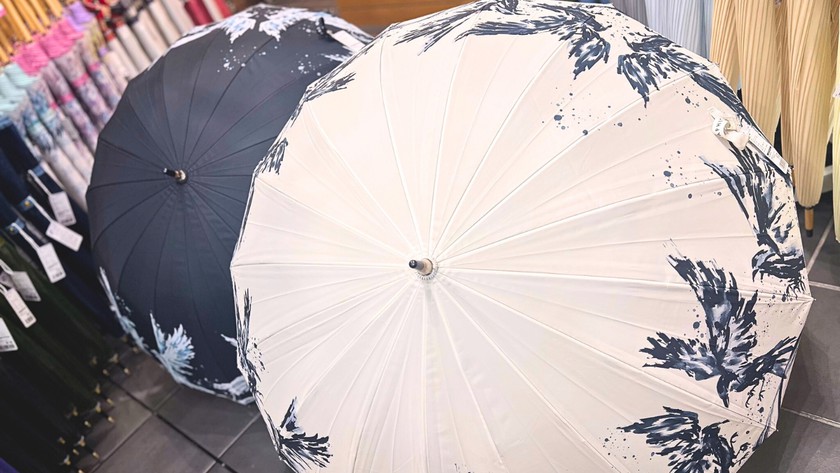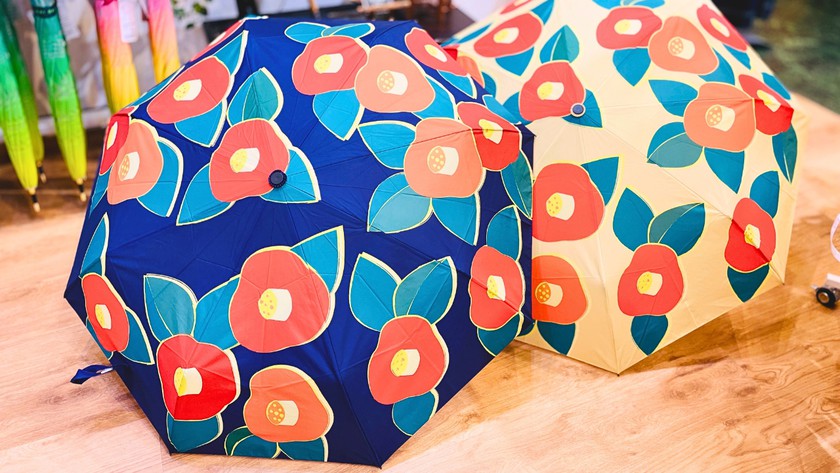Asakusa
2024.12.13
[Asakusa] Finding the Perfect Traditional Japanese Wagasa Umbrella at Hokusai Graphic in Tokyo

Umbrellas are often seen as purely functional items, chosen for practicality rather than design. While clear plastic umbrellas from convenience stores are a common sight in Japan, Hokusai Graphic, a brand specializing in Japanese umbrellas, offers a striking alternative with its “hybrid” umbrellas which seamlessly blend traditional craftsmanship with modern usability. These umbrellas aren’t just about staying dry—they’re a fusion of art and functionality, making them more than just a necessity on a rainy day. For those seeking a souvenir that is both artistic and practical, Hokusai Graphic is the ideal destination.
Table of Contents
What is a Japanese Umbrella (Wagasa)?
Before purchasing a wagasa, it’s worth taking the time to learn about their deep cultural and historical significance. At Hokusai Graphic, the friendly staff are happy to share insights into the beauty, ingenuity, and craftsmanship behind these iconic umbrellas, helping you appreciate their ingenuity and cultural significance even more. Wagasa are crafted from bamboo and washi (traditional Japanese paper), making them vastly different from their Western counterparts. Although they are made from paper, don’t be fooled—wagasa are far sturdier than they look.
Wagasa are crafted from bamboo and washi (traditional Japanese paper), making them vastly different from their Western counterparts. Although they are made from paper, don’t be fooled—wagasa are far sturdier than they look.Wagasa can be categorized into several types based on their purpose and design, with each type showcasing a unique blend of practicality and artistry. Rain-resistant types, like the bangasa, are coated with oil and a lacquer called urushi, making them durable enough to withstand wet weather. On sunny days, parasol-like higasa offer protection from the sun with their smaller sizes and colorful washi paper patterns. Meanwhile, the maigasa, with its elegant design, is frequently used in traditional performances such as kabuki or classical Japanese dance.
 An example of a bangasa crafted from bamboo and treated washi paper.
An example of a bangasa crafted from bamboo and treated washi paper.Getting Down to Bare “Bones” about Japanese Umbrellas
 One of the first things that stands out about wagasa is the number of ribs, or “bones,” in a wagasa. On a rainy, windy day in Japan, it’s common to see clear plastic convenience store umbrellas turned inside out by strong gusts, leaving people wet and frustrated. These flimsy umbrellas, with their typical eight ribs, often end up discarded in piles on trash day, broken and bent.
One of the first things that stands out about wagasa is the number of ribs, or “bones,” in a wagasa. On a rainy, windy day in Japan, it’s common to see clear plastic convenience store umbrellas turned inside out by strong gusts, leaving people wet and frustrated. These flimsy umbrellas, with their typical eight ribs, often end up discarded in piles on trash day, broken and bent. Wagasa, by contrast, are built for durability and beauty. They feature at least 16 ribs, and some, like the janomegasa (“snake-eye umbrella”), have as many as 24 ribs. These additional ribs not only strengthen the umbrella but also give it a more circular shape, which is both aesthetically pleasing and highly effective at keeping you dry. From underneath, the intricate latticework of the ribs is another testament to the craftsmanship.
Wagasa, by contrast, are built for durability and beauty. They feature at least 16 ribs, and some, like the janomegasa (“snake-eye umbrella”), have as many as 24 ribs. These additional ribs not only strengthen the umbrella but also give it a more circular shape, which is both aesthetically pleasing and highly effective at keeping you dry. From underneath, the intricate latticework of the ribs is another testament to the craftsmanship.Another striking feature is their size—they are noticeably larger than most Western umbrellas. Historically, this size served a practical purpose: to shield not only the wearer but also the hem of their kimono and the elaborate obi sash, whose knot often extends far from a woman’s back.
Exploring Hokusai Graphic’s Hybrid Japanese Umbrellas
 At Hokusai Graphic, you’ll be amazed by the brand’s modern and artistic twist on traditional Japanese umbrellas. These innovative creations combine the timeless elegance of wagasa with the lightweight, portable convenience of Western-style umbrellas, utilizing modern materials like durable carbon fiber and fiberglass.
At Hokusai Graphic, you’ll be amazed by the brand’s modern and artistic twist on traditional Japanese umbrellas. These innovative creations combine the timeless elegance of wagasa with the lightweight, portable convenience of Western-style umbrellas, utilizing modern materials like durable carbon fiber and fiberglass. Beyond their stunning appearance, these umbrellas are impressively functional. Folding umbrellas from Hokusai Graphic are all-purpose and highly light-blocking, perfect for Japan's intense summers. The designs range from elegant and understated patterns to playful and whimsical motifs—such as tsubaki (common camellia) or sumo wrestlers floating on inner tubes. Some blackout parasols even offer 99.9% UV shielding, keeping users cool under the scorching sun. Each design is an exclusive creation by Hokusai Graphic, making the hardest part of any visit deciding which one to take home.
Beyond their stunning appearance, these umbrellas are impressively functional. Folding umbrellas from Hokusai Graphic are all-purpose and highly light-blocking, perfect for Japan's intense summers. The designs range from elegant and understated patterns to playful and whimsical motifs—such as tsubaki (common camellia) or sumo wrestlers floating on inner tubes. Some blackout parasols even offer 99.9% UV shielding, keeping users cool under the scorching sun. Each design is an exclusive creation by Hokusai Graphic, making the hardest part of any visit deciding which one to take home.
Japanese Wagasa Umbrellas as Practical Souvenirs
 If you’re visiting Japan and looking for a traditional yet practical souvenir, Hokusai Graphic is an excellent choice.
If you’re visiting Japan and looking for a traditional yet practical souvenir, Hokusai Graphic is an excellent choice.Hokusai Graphic’s janomegasa is a two-tone design that features colors inspired by ukiyo-e prints, including the iconic Under the Wave off Kanagawa, also known as the The Great Wave, by none other than the store’s namesake, Katsushika Hokusai. This subtle nod to Japanese culture not only adds a layer of meaning to the umbrella’s design, but also makes it a great conversation starter when someone compliments you on your unique umbrella.
 The folding umbrellas featuring designs inspired by sometsuke, a traditional Japanese porcelain painting technique, are particularly eye-catching. Another standout is the elegant Japanese koi fish pattern adorning one of the brand’s sixteen-rib umbrellas, showcasing Hokusai Graphic’s dedication to blending traditional motifs with modern design.
The folding umbrellas featuring designs inspired by sometsuke, a traditional Japanese porcelain painting technique, are particularly eye-catching. Another standout is the elegant Japanese koi fish pattern adorning one of the brand’s sixteen-rib umbrellas, showcasing Hokusai Graphic’s dedication to blending traditional motifs with modern design. For those looking for a balance of tradition and practicality, the folding umbrella with a stunning crane and pine tree pattern on a teal background offers the perfect mix of elegance and functionality. Accessories like a towel-lined umbrella case are also available, ideal for safely storing a wet umbrella in your bag without worrying about leaks.
For those looking for a balance of tradition and practicality, the folding umbrella with a stunning crane and pine tree pattern on a teal background offers the perfect mix of elegance and functionality. Accessories like a towel-lined umbrella case are also available, ideal for safely storing a wet umbrella in your bag without worrying about leaks.Whether you’re captivated by the tradition of wagasa or the innovation of hybrid umbrellas, there’s something for everyone. These umbrellas not only make a functional keepsake but also offer a unique opportunity to learn about Japanese culture through beautifully crafted designs!
How to Get to Hokusai Graphic (Harajuku Store) from HOTEL TAVINOS Asakusa
As of November 2024, Hokusai Graphic operates 13 stores across Japan, including two in Tokyo—one in Shinjuku and another in Harajuku. For visitors staying in Asakusa, the Harajuku store is easily accessible via the Tokyo Metro Ginza Line, with no train transfers required.[By Train] approximately 35 minutes from Asakusa Station to Omotesando Station via the Tokyo Metro Ginza Line. From Omotesando Station, take a 7-minute walk directly to the store.

Hokusai Graphic Harajuku Store
Address: Harajuku BOX, 4-28-14 Jingumae, Shibuya-ku, TokyoHours: 12:00 pm – 8:00 pm (Weekdays), 11:30 am – 8:00 pm (Weekends and Holidays)
Access: 5-minute walk from Tokyo Metro Meiji-jingumae Station, or 7-minute walk from Tokyo Metro Omotesando Station
Website: https://www.hokusai-graphic.com/harajyuku
Instagram: https://www.instagram.com/hokusaigraphic/
Writer
Rachael AokiOriginally from the East Coast of the United States, Rachael has called Japan home for over a decade. She enjoys discovering destinations that are popular with locals from quaint cafes to hole-in-the-wall eateries and sharing that information with visitors from overseas. She also loves taking trips to onsen and is always up for a trip to Hakone, Kanagawa.
